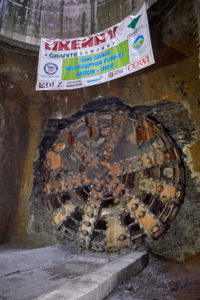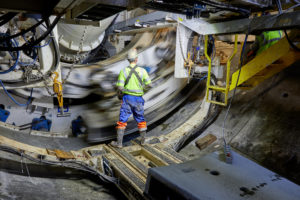Project Categories: Conveyors
Ohio Canal Interceptor Tunnel
Project Overview 
The Ohio Canal Interceptor Tunnel (OCIT) is the key component of the City of Akron’s Long Term Control Plan aimed at reducing Combined Sewer Overflows (CSOs) into the Little Cuyahoga River, and surrounding streams. Akron Waterways Renewed, is the city’s water initiative. The mission of this initiative is to promote the benefits of the OCIT and related structures and dispense knowledge about the EPA-mandated solution to clean up the city’s waterways. The 1900 m (6,200 ft) long OCIT is able to handle 1703 L (450 gallons) of CSO annually in a 8 m (27 ft) finished inside diameter tunnel. The tunnel will be able to achieve water storage and maximize conveyance and green infrastructure.
Geology
The OCIT passed through three zones or reaches that had distinctly different ground conditions. The generalized ground conditions in these reaches consisted of soft ground (Reach No. 1), mixed face conditions with soft ground overlying bedrock (Reach No. 2), and bedrock with two sections of low rock over (Reach No. 3). The rock in Reaches 2 and 3 consisted primarily of weathered shale which transitioned to shale, siltstone, and minor amounts of sandstone.
In Reach 2 there were four obstructions that were encountered within the soft ground section that consisted of natural deposited boulders. The bedrock in Reach 2 was observed to have very widely spread horizontal clay seams in the rock core.
Within Reach 3 a zone of completely weathered bedrock was encountered at the top of the bedrock surface. Very widely spread horizontal clay was also observed in the rock core, ranging from 1 to 3 inches thick along the tunnel alignment in Reach 3.
The Machine and Continuous Conveyor
The Crossover XRE included features of EPB and Hard Rock Shield TBM types, with a versatile cutterhead design built specifically to address a common issue in mixed ground TBM tunneling: abnormal flat and multi flat cutter wear, which results in the cutter wearing flat on part of its surface. The XRE TBM cutterhead was equipped with 56 housings that could be dressed in either knife bits/rippers or 17-inch disc cutters. Due to the geological variability, it was decided that disc cutters would be beneficial from the outset, so the machine was launched with a full dressing of discs.
For boring in soft ground, the pre-torque of the cutter bearings was reduced by 25%, in order to require less rolling force for each cutter to rotate evenly. Sacrificial rippers were welded to intervene in case of ring wear greater than 15 mm (0.6 in), to avoid hyperbaric intervention in the first 491 m (1610 ft) of boring. 
The screw conveyor was another customized component of the TBM, in a shaft-type design, 20 m (64.5 ft) long, 1.2 m (47 inches) in diameter, with a tapered front nose to 1 m (30 in).
In both rock mode and mixed ground, the auger and the casings were in contact with abrasive material, creating wear. The screw conveyor was designed for an abrasive environment, with chromium carbide wear plates and hard facing.
For muck removal, a Robbins Continuous Conveyor system was employed. The conveyor system consisted of a main drive, splice stand, storage unit, and advancing tailpiece, operating through several curves requiring patented self-adjusting curve idlers that adjust belt tension based on the belt load. The system discharged onto a customer-supplied overland conveyor, which delivered the muck to a large storage yard near the portal site.
Excavation
In October 2017, the TBM was launched, with a depth to invert of approximately 12 m (40 ft) through a jet grout plug installed to provide a controlled launch environment. Cutterhead clogging was a problem but was overcome easily enough. The launch of the TBM was one of the most arduous aspects of this project due to the geology of the site. The machine launched into a very short reach of 61 m (200 ft) of soft ground, which then transitioned into mixed ground for 183 m (600 ft).
While in soft ground and mixed face conditions the machine operated in closed mode, and then switched to open mode once the crews hit solid rock. The advance rates once in full-face shale rock reached a high of 34 m (111 ft) in one day (two 10-hour shifts). Continuous conveyor availability remained high throughout the bore.
With the launch, the machine was nicknamed “Rosie” in respect and honor of Rosie the Riveter, an icon representing American women who worked in factories and shipyards during World War II.
Breakthrough
On August 29, 2018, the 9 m (30.4 ft) diameter Robbins Crossover (XRE) TBM completed its mission at the Akron Ohio Canal Interceptor Tunnel (OCIT). With tunneling complete, the machine was disassembled and removed from its retrieval shaft.
Recent Posts
- Twin Robbins EPBs make milestones near Taj Mahal
- Long Haul TBM: Use of a Rebuilt Main Beam Machine at the DigIndy Tunnel System in Indianapolis, IN
- Evaluating TBM Design and Performance, 30 Years Apart: The Lesotho Highlands Water Tunnel, Phase 1 and Phase 2
- Overcoming Mountainous Geology at Nepal's Sunkoshi Marin Project
- Swift Robbins TBM breaks through 11 Months Early

 Close
Close  Menu
Menu 